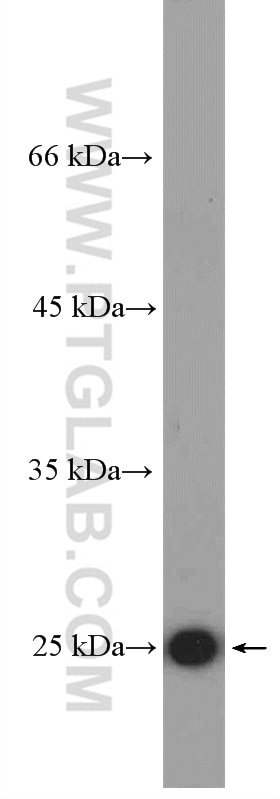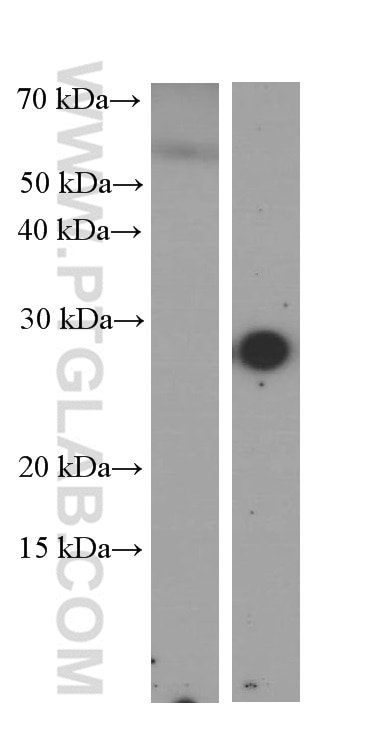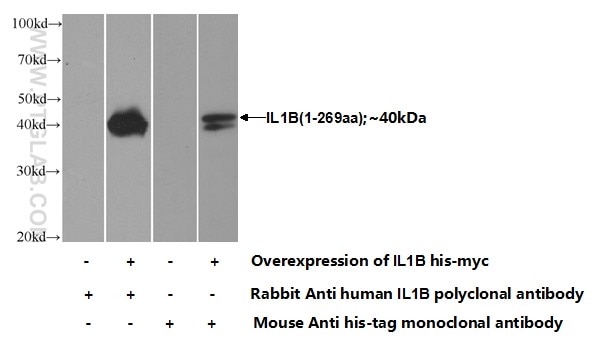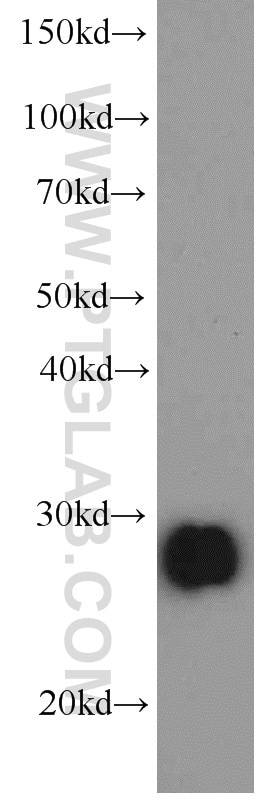- Phare
- Validé par KD/KO
Anticorps Polyclonal de lapin anti-Pentraxin 3
Pentraxin 3 Polyclonal Antibody for WB, IF, ELISA
Hôte / Isotype
Lapin / IgG
Réactivité testée
Humain, rat, souris et plus (1)
Applications
WB, IHC, IF/ICC, ELISA
Conjugaison
Non conjugué
N° de cat : 13797-1-AP
Synonymes
Galerie de données de validation
Applications testées
| Résultats positifs en WB | cellules HUVEC, cellules HeLa, cellules HepG2, cellules Jurkat |
| Résultats positifs en IF/ICC | cellules HepG2 |
Dilution recommandée
| Application | Dilution |
|---|---|
| Western Blot (WB) | WB : 1:500-1:2000 |
| Immunofluorescence (IF)/ICC | IF/ICC : 1:10-1:100 |
| It is recommended that this reagent should be titrated in each testing system to obtain optimal results. | |
| Sample-dependent, check data in validation data gallery | |
Applications publiées
| KD/KO | See 5 publications below |
| WB | See 24 publications below |
| IHC | See 9 publications below |
| IF | See 9 publications below |
Informations sur le produit
13797-1-AP cible Pentraxin 3 dans les applications de WB, IHC, IF/ICC, ELISA et montre une réactivité avec des échantillons Humain, rat, souris
| Réactivité | Humain, rat, souris |
| Réactivité citée | rat, bovin, Humain, souris |
| Hôte / Isotype | Lapin / IgG |
| Clonalité | Polyclonal |
| Type | Anticorps |
| Immunogène | Pentraxin 3 Protéine recombinante Ag4624 |
| Nom complet | pentraxin-related gene, rapidly induced by IL-1 beta |
| Masse moléculaire calculée | 381 aa, 42 kDa |
| Poids moléculaire observé | 40-45 kDa |
| Numéro d’acquisition GenBank | BC039733 |
| Symbole du gène | Pentraxin 3/PTX3 |
| Identification du gène (NCBI) | 5806 |
| Conjugaison | Non conjugué |
| Forme | Liquide |
| Méthode de purification | Purification par affinité contre l'antigène |
| Tampon de stockage | PBS avec azoture de sodium à 0,02 % et glycérol à 50 % pH 7,3 |
| Conditions de stockage | Stocker à -20°C. Stable pendant un an après l'expédition. L'aliquotage n'est pas nécessaire pour le stockage à -20oC Les 20ul contiennent 0,1% de BSA. |
Informations générales
Pentraxin 3 (PTX3), also known as TNF-inducible gene 14 protein (TSG-14), is a member of the pentraxin superfamily which consists of evolutionarily conserved proteins characterized by a structural motif99, the pentraxin domain (PMID: 15771574). Pentraxin 3 can be produced by a variety of cell types including endothelial cells, smooth muscle cells, adipocytes, fibroblasts, mononuclear phagocytes, and dendritic cells, and its expression is induced by primary inflammatory signals, such as IL-1, TNF, and microbial moieties (PMID: 15771574). Pentraxin 3 is an acute phase glycoprotein that plays a role in the regulation of innate resistance to pathogens, inflammation, tissue remodeling and repair, female fertility and cancer (PMID: 29412047). Pentraxin 3 is a biomarker for cardiovascular disease (PMID: 22347626). Increased plasma Pentraxin 3 levels have been found in patients with cardiovascular disorders (PMID: 22347626; 31057548). In WB, there're two major bands, an upper signal at 80-86 kDa and a lower signal at 42 kDa, representing Pentraxin 3 dimers and monomers, respectively (PMID: 18223257).
Protocole
| Product Specific Protocols | |
|---|---|
| WB protocol for Pentraxin 3 antibody 13797-1-AP | Download protocol |
| IF protocol for Pentraxin 3 antibody 13797-1-AP | Download protocol |
| Standard Protocols | |
|---|---|
| Click here to view our Standard Protocols |
Publications
| Species | Application | Title |
|---|---|---|
Nat Commun SH3RF3 promotes breast cancer stem-like properties via JNK activation and PTX3 upregulation. | ||
Front Cell Dev Biol Pentraxin 3 Promotes Glioblastoma Progression by Negative Regulating Cells Autophagy. | ||
Ecotoxicol Environ Saf PTX3 alleviates hard metal-induced acute lung injury through potentiating efferocytosis. | ||
J Proteomics Identification of colonic fibroblast secretomes reveals secretory factors regulating colon cancer cell proliferation. | ||
CNS Neurosci Ther PTX3 mediates the infiltration, migration, and inflammation-resolving-polarization of macrophages in glioblastoma.
|













